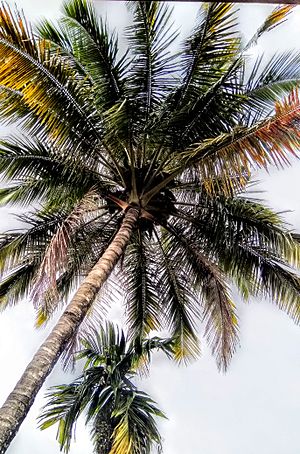Coconut production in Sri Lanka facts for kids
Coconut trees are super important to Sri Lanka's economy! These amazing trees are scientifically called Cocos nucifera. In Sri Lanka, you can find three main types: the tall kind, the dwarf kind, and the special King coconut. Sri Lanka is actually one of the world's biggest coconut producers, making over 2.6 million tonnes in 2018!
Contents
History of Coconuts in Sri Lanka
When the Portuguese arrived in Sri Lanka in 1505, they called the coconut "Coco" because the peeled nut looked a bit funny to them. Coconuts originally came from Southeast Asia and Sri Lanka.
A famous Italian traveler named Marco Polo was one of the first Europeans to write about coconuts. He even said Sri Lanka was the most beautiful island he had ever seen! Ancient Sri Lankan writings also mention coconuts. For example, a text from the 9th century, the Sigiri kurutu gee, talks about them. The ancient book Mahawansa says coconuts were grown during the time of King Aggabodhi (around 564-598 AD). Even an old Chinese Buddhist monk, Faxian, wrote about seeing coconuts in Sri Lanka during his travels (337-422 AD).
When the British took over the coastal areas, they even put a tax on coconut trees! You can still see how important coconuts were by looking at place names in Sri Lanka. Many towns like Polwatta, Polgolla, and Polgahawela have "Pol" in their name, which means "Coconut" in Sinhala!
Old Stories About Coconuts
Some old stories say that when Prince Vijaya first landed in Sri Lanka, he was offered refreshing young coconut water by a local queen named Kuweni. This shows how long coconuts have been a part of life in Sri Lanka!
Where Coconuts Grow in Sri Lanka
Coconut palms grow almost everywhere in Sri Lanka, except in very high mountain areas. They are strong trees that love sunlight and good soil. Most of Sri Lanka's coconuts are grown in a special area called the "Coconut Triangle." This triangle is formed by the towns of Puttalam, Kurunegala, and Gampaha.
What a Coconut Tree Looks Like
Coconut palms make Sri Lanka a truly beautiful place! The tall, graceful trunk of a coconut tree can grow up to 30 meters (about 100 feet) high. At the very top, it has a bunch of 30 to 40 large, feathery leaves. Each leaf can be about 3 to 4 meters (10-13 feet) long!
The coconut fruit itself has three layers. The outside is a shiny, green layer called the epicarp, which turns brown when the nut is ripe (except for the orange King coconut!). Inside that is the thick, fibrous husk, called the mesocarp. This husk acts like a cushion, protecting the seed when it falls. It also helps the coconut float, so it can travel long distances across the sea! Inside the husk is the hard, woody shell, called the endocarp.
Types of Coconuts in Sri Lanka
There are many different types of coconuts grown in Sri Lanka, each with its own special features:
| Common Name | Cool Features |
|---|---|
| CRIC 60 | Produces lots of nuts each year, about 12,000 nuts per hectare! |
| Gon Thembili | Can produce up to 20,000 nuts per hectare each year! |
| Kapruwana | Starts producing coconuts really fast, in just 3-4 years! |
| King Coconut | Medium-sized trees with orange coconuts that have sweet water. They produce 25-50 nuts per bunch. |
| Rathran Thembili | A special type that's great for home gardens. |
| Green Dwarf | A smaller, hybrid type that can also produce up to 20,000 nuts per hectare each year! |
How Coconuts Are Used
Coconut Leaves
The very young, tender inner part of the coconut stem, called "palm cabbage," is sometimes eaten as a special treat. The young, yellowish leaves, known as Gok kolla, are used for decorations. Ancient writings from the Polonnaruwa period (1055–1232 AD) mention using Gok leaves for decorations.
Today, Gok leaves are still used to decorate for special events like weddings, religious ceremonies, and even funerals. For example, at a traditional Sri Lankan wedding ceremony, tender Gok leaflets are used to decorate the Poruwa, which is the special platform where the bride and bridegroom stand. Dried leaves are also used to make "cadjans" for partitioning houses or for temporary roofs. The strong midribs of the leaflets are used to make brooms!
Sweet Coconut Sap and Jaggery
A sweet, refreshing drink called "sweet toddy" (Pol ra) can be collected from the young flower stalks of the coconut tree. To get this, the flower stalk is tied up tightly before it opens, and the end is sliced off. A pot is hung below the cut end to collect the sweet sap. A healthy tree can produce about a liter of this sweet sap every day!
The people who collect this sap are called "toddy tappers." They are very skilled! They use a small wooden hammer and a curved knife. To make their job easier, strong ropes connect nearby coconut trees at the top. The tapper can walk along these ropes from one tree to the next without having to climb down and up each time!
This unfermented sweet sap can be boiled down to make a thick, sweet syrup called treacle. If you boil it even more, it gets thicker and can be poured into clean coconut shells to cool and harden into a solid block called jaggery. Jaggery is a natural sweetener used in many delicious Sri Lankan sweets and treats!
Images for kids



